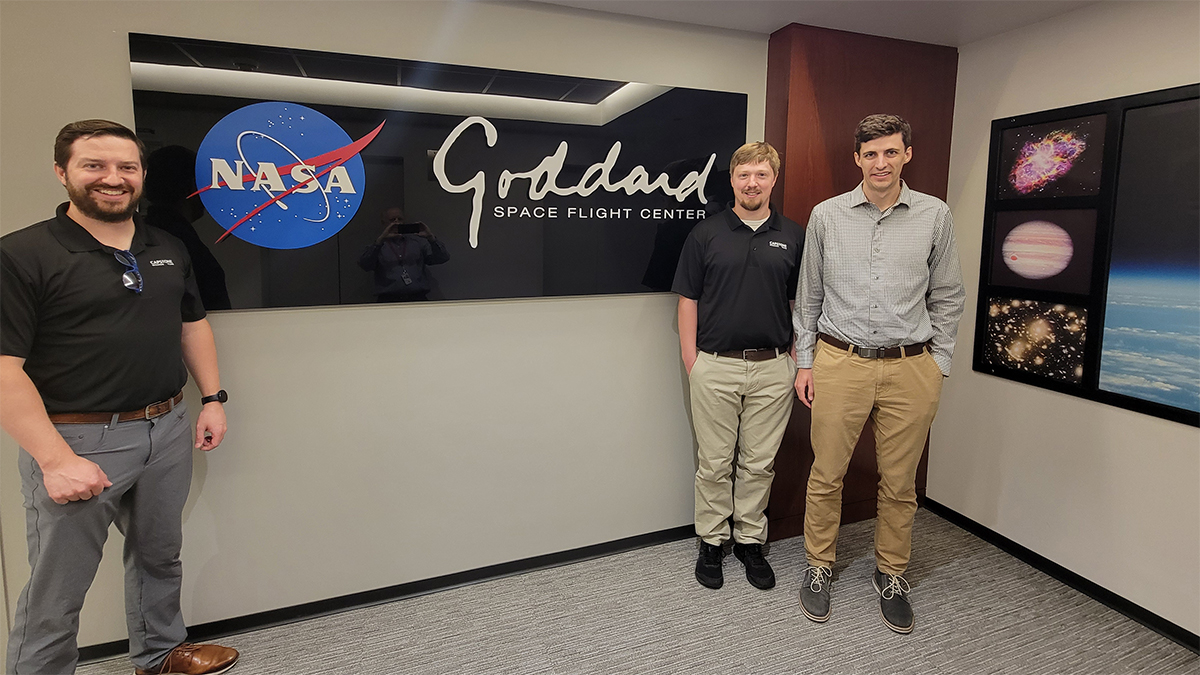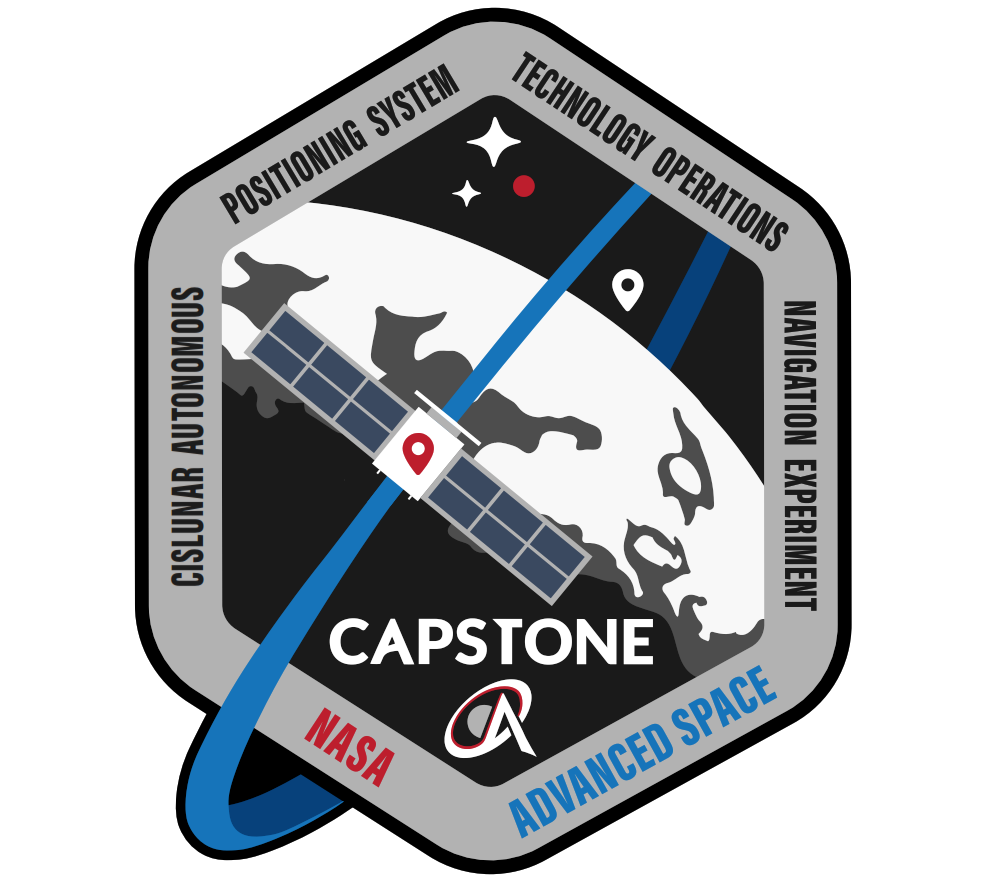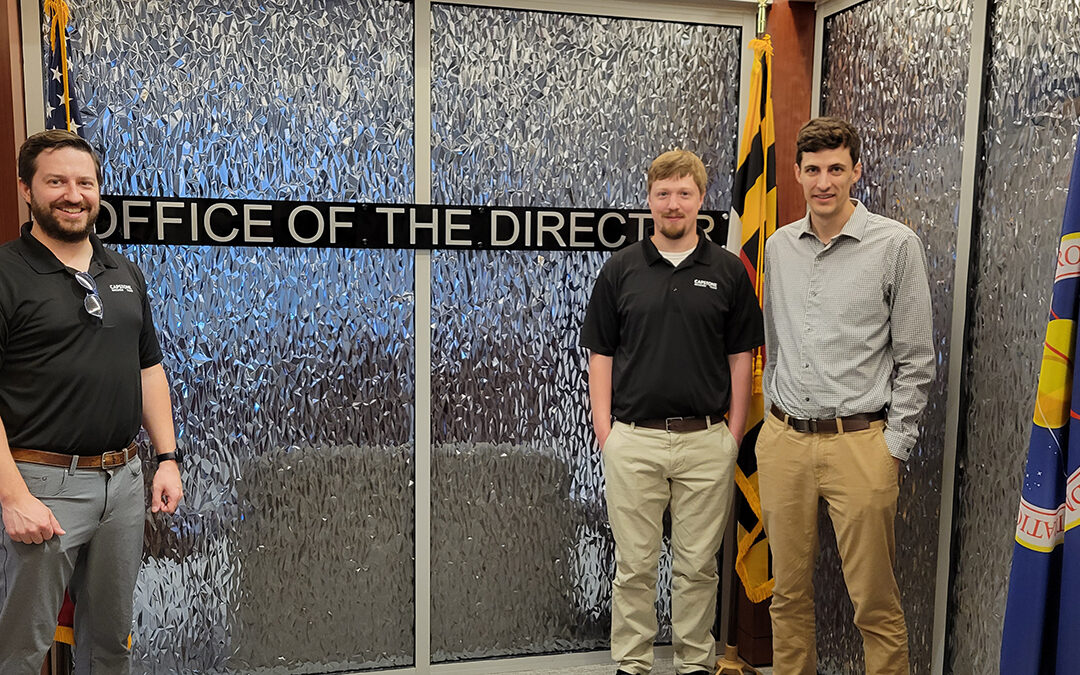Advanced Space CEO Bradley Cheetham and two team members of the Cislunar Autonomous Positioning System Technology Operations and Navigation Experiment (CAPSTONE™) team, Alec Forsman, Mission Operations Lead and Ethan Kayser, Mission Design Lead, returned to the place where it all began—NASA Goddard Space Flight Center—to share lessons learned from the successful ongoing mission.
During its six-month primary mission that ended May 24 and now its enhanced mission, CAPSTONE has tested navigation technology with similar applications to Earth’s Global Positioning System (GPS). Testing the Advanced Space-developed Cislunar Autonomous Positioning System (CAPS) was a primary objective for the mission, as we sought to demonstrate autonomous onboard navigation for spacecraft operating in cislunar space. The first spacecraft CAPSTONE interacted with to test the CAPS was the Lunar Reconnaissance Orbiter (LRO), which is operated out of Goddard. Using the gathered data from LRO, the CAPSTONE team will seek to improve subsequent crosslink demonstrations and continue to demonstrating the operational feasibility of CAPS. In the future, additional data types will be demonstrated and incorporated into CAPS to deliver navigation knowledge to users in orbit and on the surface of the Moon. In addition to collecting data for navigation, this technical demonstration with LRO is providing lessons learned that will be critical to future deployment of communications and navigation relay systems at the Moon.
The CAPSTONE mission has overcome multiple challenges while on its journey to the Moon and completing its Base Mission. For example, CAPSTONE required a lot of positioning data from NASA’s Deep Space Network (DSN) to track and verify its Near-Rectilinear Halo Orbit around the Moon. Much of this tracking data was made possible by DSN’s addition of a 21-meter radio antenna dish based at Morehead State University in Kentucky. CAPSTONE was able to capture over 315,000 measurements from the high-demand, limited-availability network—a network that will only see more use as additional missions visit the Moon.

Advanced Space has briefed NASA program teams and continues to support technical interchanges so that lessons learned can be infused to support national objectives with regard to the Moon. Cheetham and Advanced Space teammates Alec Forsman and Ethan Kayser shared CAPSTONE’s valuable insights with NASA Goddard Space Flight Center, which is appropriate, as the original concept for CAPSTONE was born out of an Advanced Space Phase I Small Business Innovation Research (SBIR) proposal submitted to Goddard in 2017.
Recounting the mission history from launch to the end of the primary mission, the team covered technical details of the mission including details on maneuvers, navigation solutions, anomaly detection and recovery, and payload operations. The team also described how the long time-of-flight of our low-energy transfer orbit, which is typically thought of as a trade-off compared to a quicker direct transfer, actually proved to be a huge benefit as the CAPSTONE team had time to recover from a communications anomaly and stuck-thruster anomaly. Had CAPSTONE been on a direct transfer, there would not have been time to be as deliberate and careful in recovering from either anomaly.
CAPSTONE’s as-flown data matches pre-launch simulations extremely well. This was especially true for our station-keeping maneuvers, or Orbit Maintenance Maneuvers (OMMs). In flight, the team has seen a “clustering” of the direction of the OMMs, meaning that the spacecraft needed to fire its thrusters more in one particular direction along its path than others. This was predicted before launch. We also predicted that if an OMM was skipped, the next OMM would have roughly twice the magnitude, and this has been well demonstrated in flight.
Lastly, CAPSTONE’s station-keeping strategy, which also will be used by the Lunar Gateway space station, has proven to be very robust and keeps the spacecraft very near the ideal near-rectilinear halo orbit (NRHO). Overall, the spacecraft and the mission have achieved its goals while leveraging an effective partnership with Goddard Space Flight Center.
About CAPSTONE™: CAPSTONE Press Kit
CAPSTONE™ is owned and operated by Advanced Space. It is one of the first CubeSats to fly in cislunar space – the orbital area near and around the Moon – and demonstrate an innovative spacecraft-to-spacecraft navigation technology. The mission launched on June 28, 2022. Critical partners in the CAPSTONE mission include:

-
- NASA: CAPSTONE’s development is supported by the Space Technology Mission Directorate via the Small Spacecraft Technology and Small Business Innovation Research programs at NASA’s Ames Research Center in California’s Silicon Valley. The Artemis Campaign Development Division within NASA’s Exploration Systems Development Mission Directorate supported the launch and mission operations. NASA’s Launch Services Program at Kennedy Space Center in Florida was responsible for launch management. NASA’s Jet Propulsion Laboratory supported the communication, tracking, and telemetry downlink via NASA’s Deep Space Network, Iris radio design and groundbreaking 1-way navigation algorithms.
- Terran Orbital Corporation: Spacecraft design, development and implementation, hardware manufacturing, assembly, testing and mission operations support.
- Stellar Exploration: Propulsion subsystem provider.
- Rocket Lab USA, Inc.: Launch provider for CAPSTONE on a three-stage Electron launch vehicle.
- Space Dynamics Lab (SDL): Iris radio and navigation firmware provider.
- Orion Space Solutions (formerly Astra): Chip Scale Atomic Clock (CSAC) hardware provider necessary for the 1-way ranging experiment.
- Tethers Unlimited, Inc.: Cross Link radio provider.
- Morehead State University (MSU): Operates the newest “affiliated node” on the NASA Deep Space Network (DSN). Providing telemetry, tracking and control services for NASA and commercial space missions and to engage university students in deep space mission operations.
